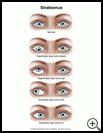
Eyes Turn In (Esotropia)
What is esotropia?
Esotropia is a type of strabismus. In esotropia, one or both eyes turn in toward the nose. It is sometimes called crossed eyes.
When a child's eyes are not aligned on the same target, the child's brain often ignores the image sent by one of the eyes to avoid confusion. That eye works less, and vision in that eye stops developing. When esotropia happens in adults, they often have double vision.
What is the cause?
Infantile esotropia usually develops by age 6 months. Its cause is not known. Without treatment, babies with esotropia will not develop the ability to use both eyes together.
Accommodative esotropia happens in farsighted children. Normally, the lens in the eye must adjust to bring near objects into focus (called accommodation). In farsighted children, more effort is needed than normal. That effort causes the eyes to cross.
Some other causes of esotropia in children are:
- nerve problems
- eye socket or eye deformities
- eye injuries
- head injuries
In adults, esotropia may be cause by the above problems, or by:
- diabetes
- thyroid disorders
- myasthenia gravis
- stroke and other blood vessel problems
What are the symptoms?
- One or both eyes appear to be turned in.
- Older children and adults may have double vision.
- The person may tilt or turn his head or squint one or both eyes.
How is it diagnosed?
Parents, caregivers, or family members usually notice that the eyes are not pointed in the same direction. An ophthalmologist (medical eye doctor) will do vision tests and check the ability to follow objects with each eye. Looking at old photographs is sometimes helpful to determine how long the eyes have been crossed.
How is it treated?
Infantile esotropia usually requires surgery. If one eye is weaker than the other (called amblyopia), the stronger eye may be patched to force the brain to use the weaker eye. Surgery on the muscles around one or both eyes can be done to correct these muscles. About 2 out of 10 people require more surgery later in life. Children with esotropia should have frequent eye exams throughout childhood.
Accommodative esotropia is usually treated with glasses. When the farsightedness is corrected with glasses, the child will not need to use as much focusing power to see close objects clearly. The eyes stay straight while the glasses are worn. The strength of the lenses may need to be changed as the child grows. Sometimes bifocals are needed. Occasionally, children will need surgery to correct the problem.
During surgery the doctor will tighten or loosen one or more eye muscles to change the direction that the eyes point. Surgery to straighten the eyes does not correct vision in the eye. It does improve the person's appearance and can help the eyes work together.
In rare cases, the eye care provider may inject a drug called botulinum into the eye muscle instead of doing surgery. This drug temporarily paralyzes the eye muscle. It may help to straighten the eye. The drug’s effects last 6 to 12 weeks. More than 1 shot is often needed.
Strabismus surgery is not cosmetic surgery. Having eyes that are not aligned normally can interfere with the ability to communicate with others through eye contact.
How long will the effects last?
Children who have esotropia need to be treated as soon as possible by an eye care provider so they can develop normal vision. Treatment that begins after the age of 6 years may improve a child's appearance but does not always help vision problems.
How can I take care of my child?
- Follow the treatment plan.
- Keep all appointments for provider visits or tests.
Last modified: 2011-10-10
Last reviewed: 2011-10-10

